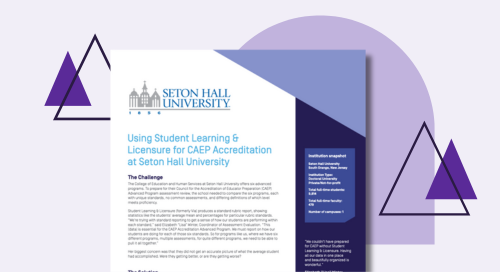The College of Education and Human Services at Seton Hall University offers six advanced programs. To prepare for their Council for the Accreditation of Educator Preparation (CAEP) Advanced Program assessment review, the school needed to compare the six programs, each with unique standards, no common assessments, and differing definitions of which level meets proficiency.
Student Learning & Licensure (formerly Via) produces a standard rubric report, showing statistics like the students’ average mean and percentages for particular rubric standards. “We’re trying with standard reporting to get a sense of how our students are performing within each standard,” said Elizabeth “Lisa” Winter, Coordinator of Assessment Evaluation. “This (data) is essential for the CAEP Accreditation Advanced Program. We must report on how our students are doing for each of those six standards. So for programs like us, where we have six different programs, multiple assessments, for quite different programs, we need to be able to pull it all together.”
Her biggest concern was that they did not get an accurate picture of what the average student had accomplished. Were they getting better, or are they getting worse?


In their quest to understand the average student, Winter and Kline developed a report called the “Average Percentage of Rubric Indicators that Meet Professional Proficiency by Student.” First, they calculated the percent of rubric elements aligned with a standard that met proficiency for each student. Then, they average those percentages over all the students. “This gives you everything you need to do the analysis you need in one file,” Winter said. “I can’t emphasize enough how much I love that.”
“We couldn’t have prepared for CAEP without Student Learning & Licensure. Having all our data in one place and beautifully organized is wonderful.”
Elizabeth “Lisa” Winter, Coordinator of Assessment Evaluation, Seton Hall University
“The biggest takeaway is that the answer to our initial question, ‘can we compare across programs?’ is yes,” Kline said.
With Student Learning & Licensure, users don’t have to let accreditation drive their choices. “We were able to respect the program for faculty decisions and still create these reports that compare across programs.”
The data in Seton Hall’s standard reports are needed mainly for accreditation, but the school can use them to report on student learning outcomes, Diversity, Equity, and Inclusion initiatives, and more.

See how our tools are helping clients right now, get in-depth information on topics that matter, and stay up-to-date on trends in higher ed.